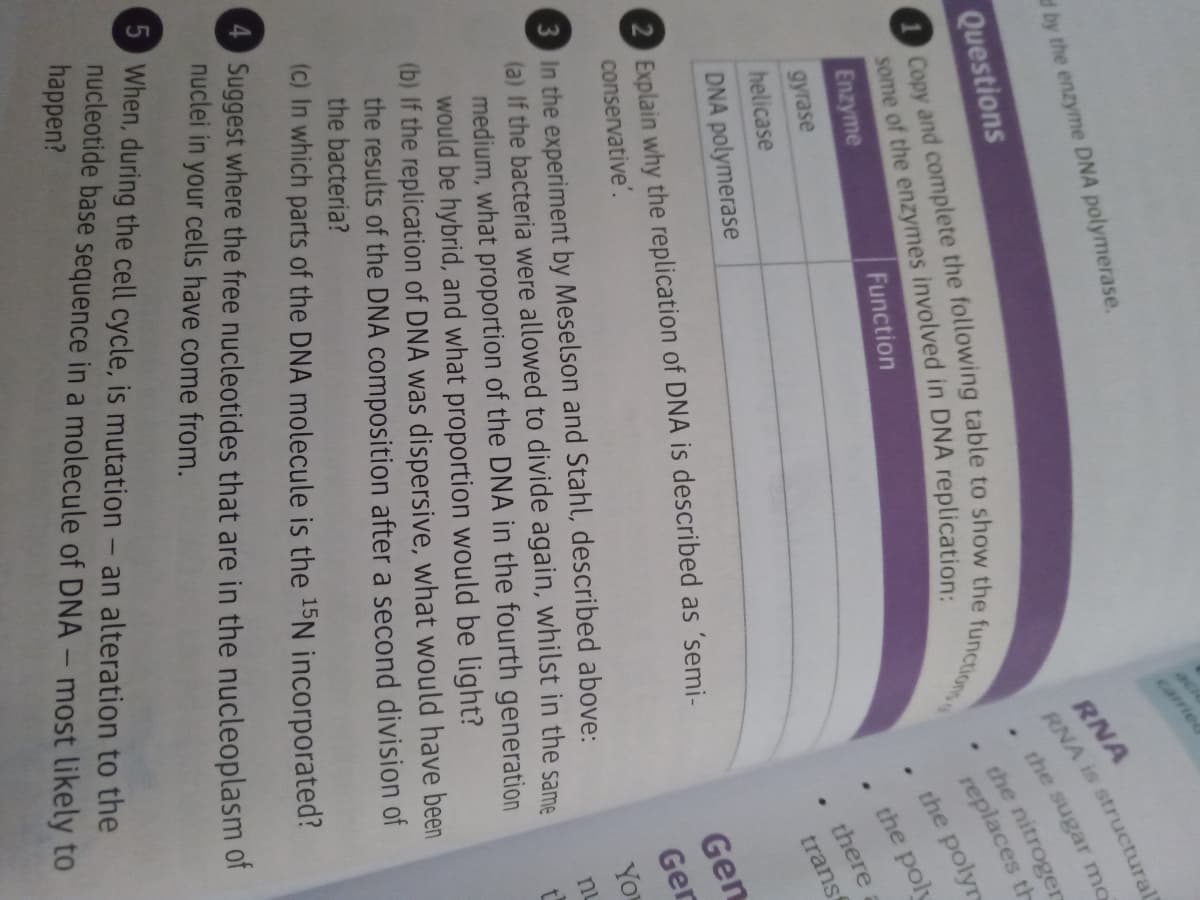d by the enzyme DNA polymerase. ack carried Questions RNA RNA is structural the sugar mo the nitroger replaces th Enzyme Function gyrase the polyr helicase DNA polymerase the poly • there 2 Explain why the replication of DNA is described as 'semi- transt conservative'. 3 In the experiment by Meselson and Stahl, described above: (a) If the bacteria were allowed to divide again, whilst in the same medium, what proportion of the DNA in the fourth generation would be hybrid, and what proportion would be light? (b) If the replication of DNA was dispersive, what would have been the results of the DNA composition after a second division of the bacteria? (c) In which parts of the DNA molecule is the 15N incorporated? Gen Ger Yo nu 4 Suggest where the free nucleotides that are in the nucleoplasm of nuclei in your cells have come from. 5 When, during the cell cycle, is mutation - an alteration to the nucleotide base sequence in a molecule of DNA - most likely to happen? some of the in replication: Copy and the table to the functions
d by the enzyme DNA polymerase. ack carried Questions RNA RNA is structural the sugar mo the nitroger replaces th Enzyme Function gyrase the polyr helicase DNA polymerase the poly • there 2 Explain why the replication of DNA is described as 'semi- transt conservative'. 3 In the experiment by Meselson and Stahl, described above: (a) If the bacteria were allowed to divide again, whilst in the same medium, what proportion of the DNA in the fourth generation would be hybrid, and what proportion would be light? (b) If the replication of DNA was dispersive, what would have been the results of the DNA composition after a second division of the bacteria? (c) In which parts of the DNA molecule is the 15N incorporated? Gen Ger Yo nu 4 Suggest where the free nucleotides that are in the nucleoplasm of nuclei in your cells have come from. 5 When, during the cell cycle, is mutation - an alteration to the nucleotide base sequence in a molecule of DNA - most likely to happen? some of the in replication: Copy and the table to the functions
Biochemistry
6th Edition
ISBN:9781305577206
Author:Reginald H. Garrett, Charles M. Grisham
Publisher:Reginald H. Garrett, Charles M. Grisham
Chapter28: Dna Metabolism: Replication, Recombination, And Repair
Section: Chapter Questions
Problem 17P
Related questions
Question
Question 4 please simple language

Transcribed Image Text:d by the enzyme DNA polymerase.
ack
carried
Questions
RNA
RNA is structural
the sugar mo
the nitroger
replaces th
Enzyme
Function
gyrase
the polyr
helicase
DNA polymerase
the poly
there
2 Explain why the replication of DNA is described as 'semi-
transt
conservative'.
3 In the experiment by Meselson and Stahl, described above:
(a) If the bacteria were allowed to divide again, whilst in the same
medium, what proportion of the DNA in the fourth generation
would be hybrid, and what proportion would be light?
(b) If the replication of DNA was dispersive, what would have been
the results of the DNA composition after a second division of
the bacteria?
(c) In which parts of the DNA molecule is the 15N incorporated?
Gen
Ger
Yo
nu
4 Suggest where the free nucleotides that are in the nucleoplasm of
nuclei in your cells have come from.
5 When, during the cell cycle, is mutation - an alteration to the
nucleotide base sequence in a molecule of DNA - most likely to
happen?
some of the in replication:
Copy and the table to the functions
Expert Solution
This question has been solved!
Explore an expertly crafted, step-by-step solution for a thorough understanding of key concepts.
Step by step
Solved in 3 steps

Knowledge Booster
Learn more about
Need a deep-dive on the concept behind this application? Look no further. Learn more about this topic, biology and related others by exploring similar questions and additional content below.Recommended textbooks for you

Biochemistry
Biochemistry
ISBN:
9781305577206
Author:
Reginald H. Garrett, Charles M. Grisham
Publisher:
Cengage Learning

Human Heredity: Principles and Issues (MindTap Co…
Biology
ISBN:
9781305251052
Author:
Michael Cummings
Publisher:
Cengage Learning

Biology Today and Tomorrow without Physiology (Mi…
Biology
ISBN:
9781305117396
Author:
Cecie Starr, Christine Evers, Lisa Starr
Publisher:
Cengage Learning

Biochemistry
Biochemistry
ISBN:
9781305577206
Author:
Reginald H. Garrett, Charles M. Grisham
Publisher:
Cengage Learning

Human Heredity: Principles and Issues (MindTap Co…
Biology
ISBN:
9781305251052
Author:
Michael Cummings
Publisher:
Cengage Learning

Biology Today and Tomorrow without Physiology (Mi…
Biology
ISBN:
9781305117396
Author:
Cecie Starr, Christine Evers, Lisa Starr
Publisher:
Cengage Learning